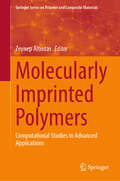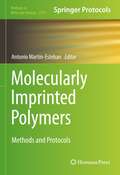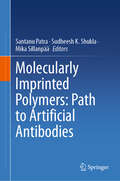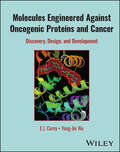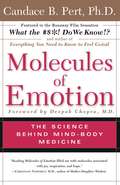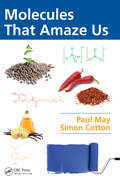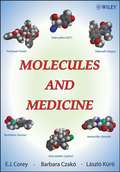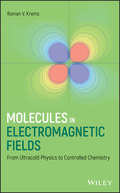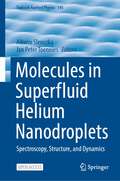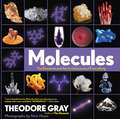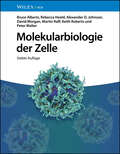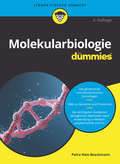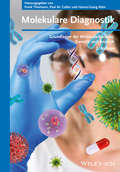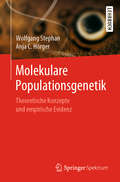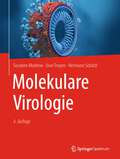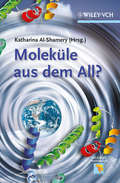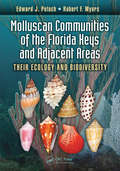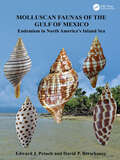- Table View
- List View
Molecularly Imprinted Polymers: Computational Studies to Advanced Applications (Springer Series on Polymer and Composite Materials)
by Zeynep AltintasThis book provides an overview of the latest technology and advances in the field of molecularly imprinted polymers (MIPs) and their diverse applications in healthcare diagnostics, food safety and quality, as well as environmental monitoring. Divided into 3 parts, the book offers an introduction to the basics of molecular imprinting and affinity materials, followed by an outline of the main sensor applications and the contribution of smart nanomaterials to molecular imprinting. The last part of the book compares MIP-based diagnostics technologies with antibody- and aptamer-based diagnostics, and discusses existing and further commercial opportunities for MIPs. Through this book, readers will get a wide range of information from basics to advanced applications in the molecular imprinting area and discover the impact of integrated approaches such as computational studies and nanotechnology on the development of imprinting techniques for biotechnological applications covering healthcare, environmental and food safety research. With its rich content, the book is a unique contribution to the field and it holds great potential to be a reference work not only for researchers working in the field but also for the researchers who plan to design collaborative research projects to contribute to their particular field (e.g., medical scientists, medical doctors, agricultural or food engineers).
Molecularly Imprinted Polymers: Methods and Protocols (Methods in Molecular Biology #2359)
by Antonio Martín-EstebanThis detailed volume explores molecularly imprinted polymers (MIPs), which have attracted great interest both in fundamental research and for practical applications due to their selective molecular recognition capabilities, extraordinary stability, and ease of preparation. Beginning with key laboratory protocols describing the different steps towards the synthesis of MIPs by different polymerization strategies, the volume continues by examining MIP use in sample preparation, their implementation on the development of sensors, as well as applications in other areas such catalysis and the use of bioinformatics and molecular modeling for MIPs design. Written for the highly successful Methods in Molecular Biology series, chapters include introductions to the respective topics, lists of the necessary materials and reagents, step-by-step, readily reproducible laboratory protocols, and tips on troubleshooting and avoiding known pitfalls. Authoritative and practical, Molecularly Imprinted Polymers: Methods and Protocols serves as an ideal guide for researchers seeking to harness this very powerful approach for the preparation of molecular selective synthetic polymers.
Molecularly Imprinted Polymers: Path to Artificial Antibodies
by Mika Sillanpää Sudheesh K. Shukla Santanu PatraThe book delves into the intricate realm of Molecularly Imprinting Polymers (MIPs) functioning as artificial antibodies. The book explores several subjects, such as the basic principles, historical development, methods for creating and analyzing MIPs, creation of specific recognition sites, computational modeling, responsive behavior to stimuli, and the nano-scale applications of MIPs. Furthermore, it emphasizes the pivotal role of MIPs in the detection of cancer, infectious diseases, and the detection of bacteria and viruses. In addition, the book explores the field of different sensor technologies, specifically focusing on MIP-based electrochemical and optical sensors. It also highlights how these sensors might be integrated into wearable, flexible, and chip sensors. In addition, the book explores developing technologies and potential future applications of MIPs as artificial antibodies. This book offers a complete grasp of the promise and limitations of MIPs by providing insights into their challenges and real-time applications. The book will be a useful resource for researchers, students, professionals, and practitioners in bioengineering, biotechnology, medicine, and ethics.
Molecularly Targeted Therapy for Childhood Cancer
by Peter J. Houghton Robert J. ArceciEach chapter will focus on the known molecular characteristics of specific childhood cancers, focusing on how the molecular 'drivers' can be exploited from a therapeutic standpoint with currently available targeted agents. Where applicable, integration of targeted therapies with conventional cytotoxic agents will be considered. This volume will provide a comprehensive summary of molecular characteristics of childhood cancers, and how the changes involved in transformation provide us with opportunities for developing relatively less toxic, but curative, therapies.
Molecules Engineered Against Oncogenic Proteins and Cancer: Discovery, Design, and Development
by E. J. Corey Yong-Jin WuMolecules Engineered Against Oncogenic Proteins and Cancer A comprehensive review of the latest molecular advances in cancer treatment Featuring 91 total small molecule kinase/KRAS inhibitors, 80 of which are FDA-approved, Molecules Engineered Against Oncogenic Proteins and Cancer documents the recent scientific advances that have transformed one of medicine’s most challenging areas—cancer treatment. Most of these inhibitors specifically block oncogene-induced carcinogenic proteins with results that have dramatically advanced the treatment of cancer. In addition, the structural formulas of more than 100 kinase/KRAS inhibitors in clinical trials are presented. With a very well-known chemist as an author, Molecules Engineered Against Oncogenic Proteins and Cancer includes information on: Each molecule’s structure, function of the kinase target and relevance to cancer, the drug discovery process, and molecular details of drug action Mutated protein kinases as oncoproteins and targets for inhibition, along with the details of discovery for each antitumor antikinase agent History of oncoprotein inhibitors and their role in advancing the treatment and understanding of cancer The discovery process as a whole, effective strategies for innovation, ongoing challenges, and a glimpse of the future of the field Combining the most significant recent discoveries in a unique and useful way, Molecules Engineered Against Oncogenic Proteins and Cancer is an essential resource for researchers and students in bioscience, medicine, chemistry, and oncology as well as for those at industrial companies involved in therapeutic discovery.
Molecules Of Emotion
by Candace B. PertWhy do we feel the way we feel? How do our thoughts and emotions affect our health? Are our bodies and minds distinct from each other or do they function together as part of an interconnected system? In MOLECULES OF EMOTION, neuroscientist Candace Pert provides startling and decisive answers to these long-debated questions, establishing the biomolecular basis for our emotions and explaining these new scientific developments in a clear and accessible way. Her pioneering research on how the chemicals inside us form a dynamic information network, linking mind and body, is not only provocative, it is revolutionary. In her groundbreaking book, Candace Pert offers a new scientific understanding of the power of our minds and our feelings to affect our health and well-being.
Molecules Of Emotion
by Candace PertWhy do we feel the way we feel? How do our thoughts and emotions affect our health? Are our bodies and minds distinct from each other or do they function together as part of an interconnected system? In MOLECULES OF EMOTION, neuroscientist Candace Pert provides startling and decisive answers to these long-debated questions, establishing the biomolecular basis for our emotions and explaining these new scientific developments in a clear and accessible way. Her pioneering research on how the chemicals inside us form a dynamic information network, linking mind and body, is not only provocative, it is revolutionary. In her groundbreaking book, Candace Pert offers a new scientific understanding of the power of our minds and our feelings to affect our health and well-being.
Molecules Of Emotion
by Candace PertWhy do we feel the way we feel? How do our thoughts and emotions affect our health? Are our bodies and minds distinct from each other or do they function together as part of an interconnected system? In MOLECULES OF EMOTION, neuroscientist Candace Pert provides startling and decisive answers to these long-debated questions, establishing the biomolecular basis for our emotions and explaining these new scientific developments in a clear and accessible way. Her pioneering research on how the chemicals inside us form a dynamic information network, linking mind and body, is not only provocative, it is revolutionary. In her groundbreaking book, Candace Pert offers a new scientific understanding of the power of our minds and our feelings to affect our health and well-being.
Molecules That Amaze Us
by Simon Cotton Paul May"This new book is by two knowledgeable and expert popularizers of chemistry and deals exclusively with molecules and compounds rather than with the simpler atoms and elements. It is based on the very successfulMolecule of the Month' website that was begun by Paul May fifteen years ago and to which his co-author Simon Cotton has been a frequent co
Molecules and Medicine
by László Kürti Barbara Czakó E. J. CoreyMolecules and Medicine provides, for the first time ever, a completely integrated look at chemistry, biology, drug discovery, and medicine. It delves into the discovery, application, and mode of action of more than one hundred of the most significant molecules in use in modern medicine. Opening sections of the book provide a unique, clear, and concise introduction, which enables readers to understand chemical formulas.
Molecules and Radiation: An Introduction to Modern Molecular Spectroscopy. Second Edition (Dover Books on Chemistry)
by Jeffrey I. SteinfeldThis unified treatment introduces upper-level undergraduates and graduate students to the concepts and methods of modern molecular spectroscopy and their applications to quantum electronics, lasers, and related optical phenomena.Starting with a review of the prerequisite quantum mechanical background, the text examines atomic spectra and diatomic molecules, including the rotation and vibration of diatomic molecules and their electronic spectra. A discussion of rudimentary group theory advances to considerations of the rotational spectra of polyatomic molecules and their vibrational and electronic spectra; molecular beams, masers, and lasers; and a variety of forms of spectroscopy, including optical resonance spectroscopy, coherent transient spectroscopy, multiple-photon spectroscopy, and spectroscopy beyond molecular constants. The text concludes with a series of useful appendixes.
Molecules in Electromagnetic Fields: From Ultracold Physics to Controlled Chemistry
by Roman V. KremsA tutorial for calculating the response of molecules to electric and magnetic fields with examples from research in ultracold physics, controlled chemistry, and molecular collisions in fields Molecules in Electromagnetic Fields is intended to serve as a tutorial for students beginning research, theoretical or experimental, in an area related to molecular physics. The author—a noted expert in the field—offers a systematic discussion of the effects of static and dynamic electric and magnetic fields on the rotational, fine, and hyperfine structure of molecules. The book illustrates how the concepts developed in ultracold physics research have led to what may be the beginning of controlled chemistry in the fully quantum regime. Offering a glimpse of the current state of the art research, this book suggests future research avenues for ultracold chemistry. The text describes theories needed to understand recent exciting developments in the research on trapping molecules, guiding molecular beams, laser control of molecular rotations, and external field control of microscopic intermolecular interactions. In addition, the author presents the description of scattering theory for molecules in electromagnetic fields and offers practical advice for students working on various aspects of molecular interactions. This important text: Offers information on theeffects of electromagnetic fields on the structure of molecular energy levels Includes thorough descriptions of the most useful theories for ultracold molecule researchers Presents a wealth of illustrative examples from recent experimental and theoretical work Contains helpful exercises that help to reinforce concepts presented throughout text Written for senior undergraduate and graduate students, professors, researchers, physicists, physical chemists, and chemical physicists, Molecules in Electromagnetic Fields is an interdisciplinary text describing theories and examples from the core of contemporary molecular physics.
Molecules in Superfluid Helium Nanodroplets: Spectroscopy, Structure, and Dynamics (Topics in Applied Physics #145)
by Jan Peter Toennies Alkwin SlenczkaThis open access book covers recent advances in experiments using the ultra-cold, very weakly perturbing superfluid environment provided by helium nanodroplets for high resolution spectroscopic, structural and dynamic studies of molecules and synthetic clusters. The recent infra-red, UV-Vis studies of radicals, molecules, clusters, ions and biomolecules, as well as laser dynamical and laser orientational studies, are reviewed. The Coulomb explosion studies of the uniquely quantum structures of small helium clusters, X-ray imaging of large droplets and electron diffraction of embedded molecules are also described. Particular emphasis is given to the synthesis and detection of new species by mass spectrometry and deposition electron microscopy.
Molecules of Emotion
by Deepak Chopra Brooke Zimmer Candace B. PertWhy do we feel the way we feel? How do our thoughts and emotions affect our health? Are our bodies and minds distinct from one another or do they function together as parts of an interconnected system? In this groundbreaking audiobook, Candace Pert -- a neuroscientist whose extraordinary career began with her 1972 discovery of the opiate receptor -- provides startling and decisive answers to these and other challenging questions that scientists and philosophers have pondered for centuries. From explaining the scientific basis of popular wisdom about phenomena like "gut feelings" to making comprehensible recent discoveries in cancer and AIDS research,Molecules of Emotionis an intellectual adventure of the highest order. Yet the journey Pert takes us on is one of personal as well as scientific discovery. Woven into her lucid explanations of the science underlying her work is the remarkable story of how -- faced with personal and professional obstacles -- she has grown as a woman and a mother, and how her personal and spiritual development has led to breakthroughs in her remarkable career. Molecules of Emotionis a landmark work. Full of insight and wisdom, it is among those rare audiobooks which possess the power to change the way we see the world and ourselves.
Molecules: The Elements and the Architecture of Everything
by Theodore Gray Nick MannIn his highly anticipated sequel to The Elements, Theodore Gray demonstrates how the elements of the periodic table combine to form the molecules that make up our world. Everything physical is made up of the elements and the infinite variety of molecules they form when they combine with each other. In Molecules, Theodore Gray takes the next step in the grand story that began with the periodic table in his best-selling book, The Elements: A Visual Exploration of Every Known Atom in the Universe. Here, he explores through fascinating stories and trademark stunning photography the most interesting, essential, useful, and beautiful of the millions of chemical structures that make up every material in the world. Gray begins with an explanation of how atoms bond to form molecules and compounds, as well as the difference between organic and inorganic chemistry. He then goes on to explore the vast array of materials molecules can create, including: soaps and solvents; goops and oils; rocks and ores; ropes and fibers; painkillers and dangerous drugs; sweeteners; perfumes and stink bombs; colors and pigments; and controversial compounds including asbestos, CFCs, and thimerosal.Theodore Gray is the author of The Elements: A Visual Exploration of Every Known Atom in the Universe; Theo Gray's Mad Science: Experiments You Can Do At Home, But Probably Shouldn't; Mad Science 2: Experiments You Can Do At Home, But Still Probably Shouldn't; and Popular Science magazine's "Gray Matter" column. With his company Touch Press, Gray is the developer of best-selling iPad and iPhone apps, including The Elements, Solar System, Disney Animated, The Orchestra, The Waste Land, and Skulls by Simon Winchester. He lives in Urbana, Illinois.Nick Mann is the photographer of The Elements: A Visual Exploration of Every Known Atom in the Universe. Aside from having photographed more elements and compounds than probably anyone in the world, he is an accomplished landscape, sports, and event photographer. He lives in Urbana, Illinois.
Molekularbiologie der Zelle
by Keith Roberts David Morgan Martin Raff Peter Walter Bruce Alberts Alexander D. Johnson Rebecca HealdDie Zelle – das ganze Wissen in einem Buch „Molekularbiologie der Zelle“ ist seit 40 Jahren das führende Lehrbuch der Zellbiologie. Vollständig aktualisiert stellt die Neuauflage das sich rasch weiter-entwickelnde Wissen zum zentralen Gegenstand der Biologie dar – der Zelle. Aufbauend auf den biochemisch-molekularbiologischen Grundlagen der Lebensvorgänge werden Aufbau und Funktion von eukaryotischen Zellen und Geweben, deren Lebenszyklus und die Interaktion mit Pathogenen beschrieben. Mit erstklassiger und bewährter Didaktik führt die siebte Auflage dieses weltweiten Klassikers sowohl in die grundlegenden Konzepte der Zellbiologie als auch in deren faszinierende Anwendungen in Medizin und Biotechnologie ein: durchgehend aktualisiert mit einem Fokus auf Aspekten der Evolution und Biodiversität neue Unterkapitel zu Modellorganismen, zur DNA-Reparatur und zum humanen Mikrobiom stellt aktuelle Themen verständlich dar, wie biomolekulare Kondensate, korrelative Mikroskopie, Tumorgenomforschung, Coronaviren und mRNA-Impfstoffe Fast 1500 anschauliche Farbabbildungen, die zum großen Teil neu gestaltet wurden 21 großformatige Tafeln verdeutlichen komplexe Vorgänge, klassische Experimente und aktuelle Methoden weiterführende Literatur mit wichtigen Originalarbeiten und Lehrbüchern Glossar mit mehr als 1100 grundlegenden Begriffen Studierende in den Fächern Molekularbiologie, Genetik, Zellbiologie, Biochemie und Biotechnologie führt dieses Buch vom ersten Semester des Bachelor- bis ins Master-Studium und darüber hinaus. Aus Rezensionen zu früheren englisch- und deutschsprachigen Auflagen „Jede Seite zeugt von der Liebe der Autoren zum exakten Detail, gleichzeitig aber von ihrer Anstrengung, Wissen aus einem schier unüberschaubaren Fachgebiet leicht erfassbar und gut lesbar aufzubereiten. … Der klare, prägnante Stil, die Fülle an informativen Diagram-men und Abbildungen setzen eindrucksvolle Maßstäbe.“ Nature „…Molecular Biology of the Cell gelingt es ausgezeichnet, die Fortschritte [der moleku-laren Zellbiologie] darzustellen. Auch aus der kommenden Generation von Interessenten wird es niemand auch nur einen Moment bedauern, sich dieses Werk zugelegt zu haben.“ Cell „Man spürt, wie sehr es den Autoren daran gelegen ist, ihre eigene Begeisterung für ihr Metier auf den geneigten Leser zu übertragen. … Wer hier einmal eingestiegen ist, wird nur schwerlich wieder herausfinden, denn Biologie live macht süchtig. … Das Buch … gehört auf das Bücherregal jedes Lebenswissenschaftlers …“ BIOspektrum „Gleichgültig, was man gerade sucht: immer wird mehr geboten als erwartet … Beispiel-haft sind nicht nur die verständlichen, prägnanten Texte, sondern auch die großzügigen, durchwegs farbigen Illustrationen.“ Frankfurter Allgemeine Zeitung
Molekularbiologie für Dummies (Für Dummies)
by Petra Neis-BeeckmannDas Leben begann klein, mit den Einzellern: Auf noch kleinerer Ebene arbeitet die Molekularbiologie. DNA, RNA und ihre Wechselwirkung mit Proteinen sind ihre Gebiete. Dieses Buch erklärt Ihnen den Aufbau von DNA, RNA, Proteinen und Enzymen, beschreibt die Einsatzgebiete von Viren, Bakterien und Vektoren. Sie erfahren zudem verständlich und fundiert, was Sie über die molekularbiologischen Standardmethoden, Elektrophorese, Polymerase-Kettenreaktion und Sequenz-Analyse wissen sollten. Ein Einblick in die tägliche Arbeit von Molekularbiologen und die Arbeit mit Genprodukten rundet das Buch ab.
Molekularbiologie: für Biologen, Biochemiker, Pharmazeuten und Mediziner (Verdammt clever!)
by Mike White Phil Turner Bärbel Häcker Andy Bates Alexander McLennanKompakt und »verdammt clever« auf den Punkt gebracht – vermittelt Molekularbiologie das unverzichtbare Grundwissen zu Struktur, Biosynthese und Funktion von DNA und RNA und erklärt, wie diese untereinander und mit Proteinen interagieren. Endlich ein maßgeschneidertes Kurzlehrbuch für Studenten, die auf der Suche nach einer knappen Einführung in dieses grundlegende Fachgebiet sind: • Ideal für Einsteiger! Beschränkt sich auf die wirklich wichtigen Themen der Molekularbiologie und fasst die wesentlichen Fakten und Begriffe für jedes Thema zusammen. • Einprägsam! Klare Abbildungen erleichtern das Lernen und Verstehen, Querverweise auf verwandte Kapitel zeigen Zusammenhänge auf und fördern so das Verständnis. • Ausgezeichnete Prüfungsvorbereitung! Ermöglicht strukturiertes Lernen und schnelles Wiederholen durch einzigartigen Kapitelaufbau – mit über 70 Fragen und Antworten.
Molekularbiologische Methoden in der Lebensmittelanalytik
by Ulrich BuschMolekularbiologische Verfahren werden seit Längerem in der Analytik von Lebensmitteln, Saatgut und Futtermitteln angewendet. Das Spektrum reicht vom Nachweis gentechnisch veränderter und allergener Inhaltsstoffe über die Tierartendifferenzierung in Fleischprodukten bis zur Bestimmung pathogener Keime. Das Buch vermittelt in äußerst praxisbezogener Weise die notwendigen molekularbiologischen Techniken und das nötige Hintergrundwissen. Einen Schwerpunkt bildet die Polymerase-Kettenreaktion (PCR), einschließlich Realtime-PCR und Qualitätssicherung.
Molekulare Diagnostik
by Hanns-Georg Klein Frank Thiemann Paul M. CullenSpeziell für MTAs entwickelt, gibt das Buch nicht nur eine praxisnahe Einführung in die Diagnostik, sondern auch ist gleichzeitig eine hervorragende Einführung in die Molekularbiologie und Genetik. Das Buch nimmt somit einen zentralen Platz in der MTA Ausbildung ein.
Molekulare Populationsgenetik: Theoretische Konzepte und empirische Evidenz
by Wolfgang Stephan Anja C. HörgerDas Buch behandelt die genetische Vielfalt von Populationen von Organismen. Es erläutert, wie genetische Vielfalt gemessen wird und wie aus diesen Daten die Mechanismen untersucht werden können, die die Variabilität auf der Genomebene und damit die Mikroevolution einer Population beeinflussen. Ziel dieses Buches ist es, das Wirken der natürlichen Selektion im Genom zu verstehen und vom Einfluss neutraler Evolutionskräfte (wie genetischer Drift, Mutation und Rekombination) unterscheiden zu lernen. Dazu werden die grundlegenden theoretischen Konzepte der Populationsgenetik eingeführt und anhand von zahlreichen Beispielen aus allen Organismengruppen (Menschen, Tieren, Pflanzen und Mikroorganismen) veranschaulicht. Um das Verständnis der theoretischen Ableitungen von Hypothesen und der darauf basierenden Datenanalysen zu überprüfen und weiter zu vertiefen, schließt jedes Kapitel mit Übungsaufgaben und Lösungen ab.
Molekulare Virologie
by Hermann Schätzl Susanne Modrow Uwe TruyenDieses bewährte Standardwerk vermittelt einen ausgewogenen Überblick über die bekannten humanpathogenen und tierpathogenen Viren, wie beispielsweise Papilloma- und Influenzaviren und wurde ergänzt um die eher neu aufgetretenen Viren, insbesondere Zikavirus, das neuartigen Coronavirus SARS-CoV-2 und das Schmallenberg-Virus, einem Bunyavirus, das Rinder, Schafe und Ziegen infiziert.Der erste Teil des Buches präsentiert die allgemeinen Prinzipien der Struktur, Vermehrung und Lebenszyklen von Viren und beschreibt die wichtigsten pathogenetischen und immunologischen Mechanismen viraler Erkrankungen. Auch die Diagnostik und Therapie sowie die Epidemiologie solcher Infektionen und das heutige Methodenrepertoire der Virologen werden hier vorgestellt.Der zweite, spezielle Teil führt systematisch durch die Vielfalt der human- und tierpathogenen Viren. Ausführlich dargestellt sind hier Morphologie, Genomorganisation, Proteinausstattung sowie Replikationsmechanismen der verschiedenen Virusfamilien. Für die jeweils wichtigsten Vertreter liefern die Autoren einen Überblick über die relevanten humanmedizinisch-klinischen beziehungsweise veterinärmedizinischen Aspekte. Auch seuchenrechtliche Fragen kommen hier zur Sprache.Das Lehrbuch dient seit vielen Jahren als bewährte Einführung in die molekular- und zellbiologischen Grundlagen der Virologie und ist unentbehrlich für Fachleute und Studierende. Die 4. Auflage wurde ergänzt mit den aktuellen Daten zu den jeweiligen Viren und bietet somit einen aktuellen Überblick zu den Replikationsstrategien und verbindet diese mit der Pathogenese der Erreger. Integriert wurden Virusspezies, die während der vergangenen Jahre neu aufgetreten sind und in vieler Hinsicht die öffentliche Diskussion beherrscht haben. Nicht zuletzt zählen hierzu die Infektionen des Menschen mit dem neuartigen Coronavirus SARS-CoV-2, dem Zikavirus, den tier- wie humanpathogenen Bornaviren sowie dem Schmallenberg-Virus, dessen Infektion bei Wiederkäuern schwere Fetopathien verursacht. Mit seiner klaren Gliederung und verständlichen Darstellung weist dieses systematisch angelegte Lehr- und Nachschlagewerk• Studierenden und Lehrenden in Biowissenschaften, Human- und Veterinärmedizin• Virologen, forschungsorientierten Klinikern, Tierärzten und Seuchenmedizinern sowie• Fachleuten in Mikrobiologie, Hygiene und Diagnostikden Weg durch die Vielfalt der virologischen Forschungsergebnisse.
Moleküle aus dem All? (Erlebnis Wissenschaft)
by Katharina Al-ShamerySpannend wie ein Krimi: Big-Bang und Leben auf dem Mars Wie kam es dazu, dass sich unsere Erde allmählich aus dem Nebel des Sonnensystems zu formen begann und was ist dran an der Theorie, dass das Leben in Form von Sporen direkt aus dem All zu uns auf die Erde transportiert wurde? Unsere bisherige Evolutionsgeschichte liest sich schon spannend wie ein Krimi. Und hier verraten international renommierte Wissenschaftler auch ihre Zukunftsvisionen, wie z. B. Professor Jesco von Puttkamer (ISS und NASA), der ergründet, ob Leben auf dem Mars möglich ist. Wie nahrhaft war die Ursuppe? Ist das Leben aus einer üppigen und vor Nährstoffen strotzenden Ursuppe entstanden, warum ist es so schwer, den Molekülbaukasten der Erde zu erforschen und kennen Sie schon das älteste überlebende Urzeitrelikt? Hier bekommen Sie alle Antworten, die die Wissenschaft bislang erforscht hat, und machen sich mit Experten auf Spurensuche - unter anderem nach dem Stoff, aus dem die Gene sind. Wo sind sie alle? Auf der Suche nach außerirdischem Leben >>Die Erde als die einzige bevölkerte Welt im All anzusehen, ist ebenso absurd wie die Behauptung, auf einem mit Hirse gesäten Feld sprieße nur ein einziges Korn.>Nachbarn<<? Und wie können die Menschen mit ihnen Kontakt aufnehmen? Die Wissenschaft arbeitet mit Nachdruck daran - und erzählt in diesem Buch, wie weit sie bisher gekommen ist.
Molluscan Communities of the Florida Keys and Adjacent Areas: Their Ecology and Biodiversity
by Edward J. Petuch Robert F. MyersMolluscan Communities of the Florida Keys and Adjacent Areas: Their Ecology and Biodiversity is the first comprehensive overview of the ecology and biodiversity of the phylum Mollusca in the area of Florida extending from the Dry Tortugas and Ten Thousand Islands in the west to Palm Beach in the east. The book provides detailed analyses of mollusca
Molluscan Faunas of the Gulf of Mexico: Endemism in North America’s Inland Sea
by Edward J. Petuch David P. BerschauerRecent biodiversity studies, reported here for the first time, have shown that the molluscan fauna of the Gulf of Mexico is far richer and more complex than previously thought. As a result of these new discoveries, the Gulf malacofauna is shown to contain large numbers of endemic species that reside within four separate biogeographical subdivisions of the larger Carolinian Molluscan Province: the Floridian, Suwannean, Texan, and Yucatanean Subprovinces. These four Gulf biotic components, with each supporting its own endemic fauna, are shown here to be separated by distinct ecological and oceanographic barriers. The resultant physical and genetic isolation has led to the evolution of spectacular sibling species radiations, many unknown and undescribed until now. Some of the most conspicuous and important of these are found in the gastropod families Fasciolariidae, Volutidae, Conidae, Muricidae, and Busyconidae, all of which are dominant predators in their respective benthonic ecosystems. The species within these ecologically important families, along with hundreds of endemic taxa in 50 other gastropod and bivalve families, are illustrated here in Molluscan Faunas of the Gulf of Mexico: Endemism in North America’s Inland Sea on 132 color plates and are discussed in detail in the individual chapters. Special attention is given to the mollusks of poorly studied and virtually unknown ecosystems such as those on the deep reefs off the Florida Keys and Dry Tortugas, the deep water coralline algal beds off western Florida, the Flower Garden Reefs off Texas, the petroleum seeps and brine pools of the Sigsbee Escarpment, the Campeche Bank Archipelago, and the deep water areas at the mouth of the Yucatan Channel.This new book is unlike previous taxonomic surveys of the Gulf of Mexico mollusks in that it highlights only the endemic species and genera and does not cover the large number of widespread Carolinian and Caribbean taxa that occur with them. In this aspect, the book is designed to be an augmentation to previous faunal surveys, adding hundreds more taxa that had been missed in these older surveys or were described after those earlier works had been published. The emphasis on endemic species and species complexes is meant to underscore the special nature of the Gulf of Mexico malacofauna, setting it aside from all others in the Tropical Western Atlantic Region.
